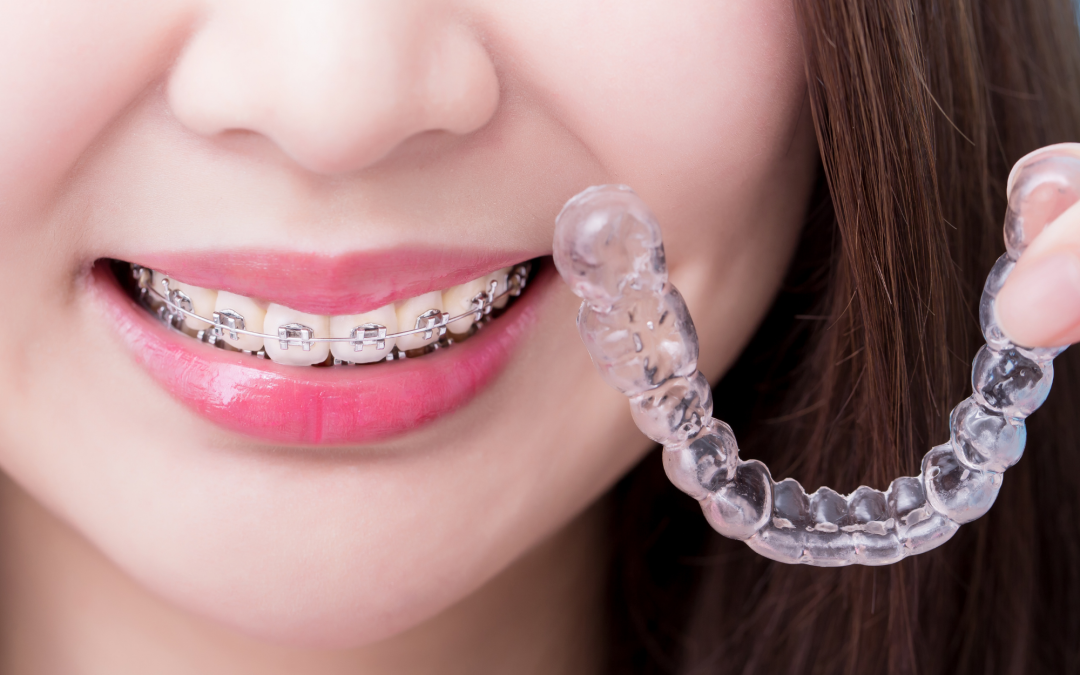You want to straighten your smile but can’t decide which way to go: do you choose Invisalign or conventional braces? You have so many more options these days, and it can be a difficult decision! But with personal research and asking your orthodontist questions, you can make an informed decision.
The Pros & Cons of Invisalign

- Invisalign is virtually invisible: The name says it all. Do you not want colleagues, classmates, or clients to see that you’re straightening your smile? Invisalign uses clear plastic, so you don’t have to be self-conscious of your orthodontic work.
- Invisalign requires fewer orthodontic appointments: When you start Invisalign, we take a 3-D scan of your teeth for the making of all your customized retainers. You will then receive new aligners in the mail, decreasing the number of visits necessary for adjustments.
- You can take Invisalign aligners out for eating: Invisalign must be worn for up to 22 hours every day, giving you enough time to take your aligners out when you are eating. You don’t have to change what or how you eat!
- It’s easier to brush and floss: You can also take your Invisalign retainers out to brush and floss your teeth without interruption.
- They are more comfortable than most braces: Moving teeth around with Invisalign can be uncomfortable and painful, much like traditional braces. However, there are also fewer mouth and gum problems with Invisalign. Unlike braces, there are typically no cuts on the inside cheeks with which patients have to deal.
Of course, there are some negatives you have to be aware of with Invisalign:
- Patients must exercise discipline: Having removable aligners can be a con as well as a pro. If you don’t have the discipline needed to keep them on for the required 22 hours a day, your treatment may not produce the best results.
- Removing and putting them back in can be a pain: When you’re out, taking out and putting your aligners back in can be a lot. You must remove them before eating and drinking anything other than water, which can be hard when out in public. Before replacing your aligners, you need to brush your teeth. You are also at increased risk of cavities and bad breath.
- Cost: Advances in the 3D scanning technology and the flexible material involved in making the aligners, the cost of Invisalign can be similar to braces.
Invisalign is not always the best treatment option: In more complex orthodontic cases, Invisalign might not be the ideal solution. Your orthodontist will give you an examination and help you to make an informed decision on which type of treatment is right for you.
The Pros & Cons Of Braces

- Braces are suitable for all treatments: It doesn’t matter how complex the case is – braces can fix almost every kind of misalignment and malocclusion. They rely on anchors and archwire to pull the teeth into the desired position, and these forces are the most powerful.
- There are more options than just conventional braces: Braces are not only traditional metal brackets and wires. Patients now have the choice ceramic braces, both of which are less noticeable. If you’re self-conscious, it’s possible to benefit from the force of braces without the metal brackets.
There are a few cons with braces, however:
- Aesthetics: Some people don’t like the look of traditional braces. They feel self-conscious about their appearance in some social settings and would prefer invisible options.
- Brushing and flossing can be difficult: You can risk plaque accumulation around the braces if you don’t clean your teeth properly. The build-up can lead to staining and decay, so patients must closely follow their orthodontist’s instructions on correctly brush and floss with braces.
- Food limitations: The variety of food and drink you consume is more limited with conventional braces. There’s no taking them out for meals, so you must be careful with any hard and sticky foods – they can break the archwire or dislodge a bracket from a tooth. If this happens, you must have the orthodontic work repaired, and this can prolong your treatment.
- Appointments are more frequent: Regular visits are necessary to check on progress and adjust your braces. About every month, your orthodontist will look at the movement of your teeth and make any necessary adjustments so that the braces continue moving your teeth in the right direction.
Invisalign Vs. Braces: How Can You Make The Right Choice?
There’s a lot to consider when weighing the options of orthodontic treatment. Before committing, compare the pros or cons above with how you’d like your experience to go, and don’t be afraid to ask your orthodontist questions. Our experienced orthodontists will advise you on the best treatment options for your specific situation. We want you to be sure you have all the information needed to make an informed decision!

